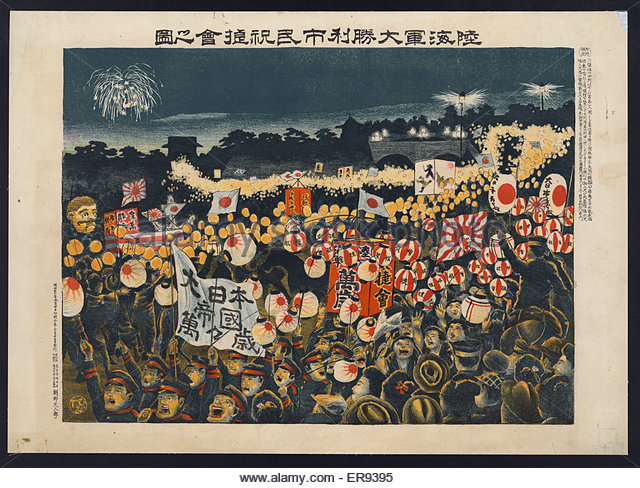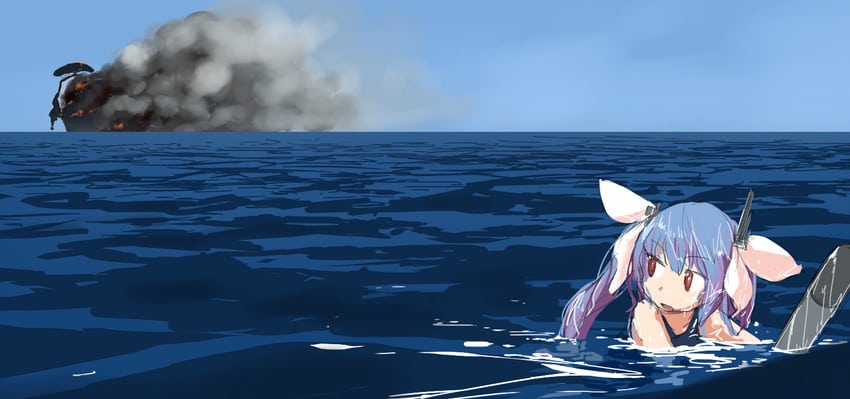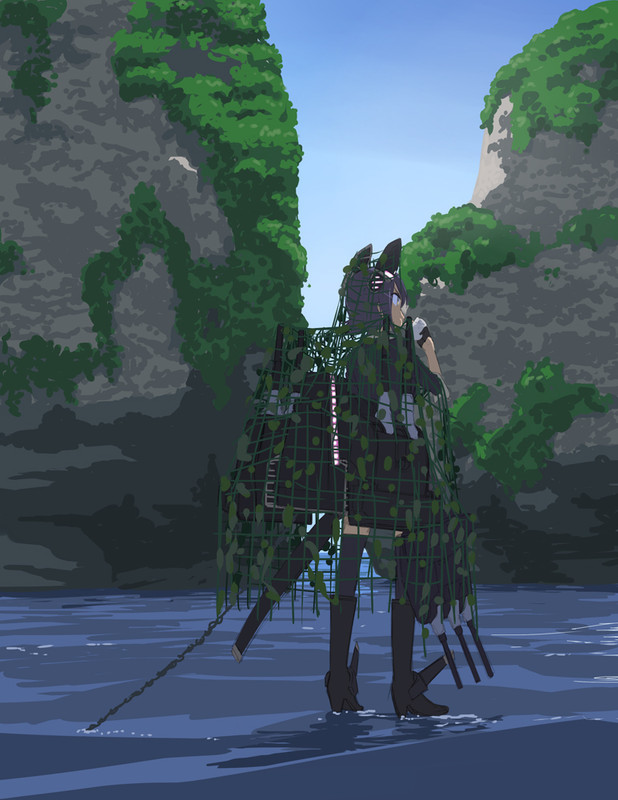
The people of the Alliance rejoiced. Many nations, united, drunk in the glory of the moment. There was a great cry that rose from Japan when Fuso sailed into the harbour; it was clear to all that the 'Lady of China' was a lucky ship. Not
once had she sailed from Japan and not returned with victory. And what a victory
that had been.
The Admiralty were also ecstatic, but less entranced by the old battleship as it dropped anchor in Sasebo and was immediately swarmed by small boats carrying flowers, flags, treats and drink for the crew. It was clear that the lighter, faster ships and the mighty torpedoes had carried the day, not the venerable battleship's guns - and it had been the fast, heavy-hitting cruisers that had accounted for the cleanup. It was clear that the Battlecruiser gamble was a move in the right direction - and
Tsukuba was five months from completion. What the Navy could do with
her in action, the Admirals could only dream of.
But for now, there were more pressing matters to attend to.
.png)
Firstly - Japan would
not allow herself to be surprised like her enemy had been. The Minesweepers of the navy swarmed out of their harbours in their assigned patrols. This was not glorious work, but it was interesting to see how well the Polynesian sailors of the Empire took to the task. With their almost supernatural skill in reading currents, changes in weather and dangerous waters, they
enjoyed the long patrols. The Minesweepers, had, after all, been fitted for colonial service; they were meant to stay on patrol for weeks on end and they proved to be the lifeblood of the Alliance this time around, tracking down French submarines and raiders; ferrying supplies to smaller islands; carrying messages and, on occasion, serving as small troop transports. Their crews became known for their rogueish behaviour and the 'Maru boys' received a warm welcome in any Japanese port.
.png)
Then - a review of the strategic situation. France's battleline had been savagely mauled and their two battlecruisers were both years away from completion. In matters of tonnage, Japan led in battleships. But the French were following the tenants of the
Jeune ecole: they had taken the tenants of light forces warfare and brought them to their extremes. Their cruiser fleet was massive, and the Admiralty felt sure that the following days would be a nightmare of raiding reports and sunken merchant ships, as the French cruisers would go to town and the Alliance did not have enough hulls to throw at them. Hopefully,
Tsukuba, capable of running down any French cruiser, would change that.
.png)
.png)
The month ended with reports from the R & D department regarding improvents in boiler design; also, having experienced first-hand the destructive power of torpedoes on the enemy, Japan focused on crafting a shield that could block the enemy's lances. Experimental designs of 'torpedo belts' and compartmentalisation were put forward. Unfortunately, it was impossible to refit them on the near-complete
Tsukuba or the
Ikoma, with its eccentric barbette placement; Japan's first two battlecruisers would go into battle defenseless against this most terrible of weapons.
And then, reports started coming in, from the Silent Service and the Coastal patrols:
.png)
.png)

I-5 scored first blood near Annam, when she sunk the 3k ton freighter
Belle Alsace. The Japanese submarine made good its escape. The French, in retaliation, sunk the
Kobayashi Maru and the
Maui. However, the French skippers had not accounted for the 'Maru boys'. Both submarines were tracked down by bloody-minded minesweepers, who stuck to their wake like limpets, until the subs were forced to surface for air; then they were blasted out of the sea in short order.
.png)
More importantly, the
Unebi and the
Chiyoda, having trained for raider warfare but not having been dispatched on raiding duty yet, knew what to look for. Twice the French raider
Tage tried to sneak into the Alliance maritime traffic lanes and twice it was forced to turn away under pursuit by her Japanese rivals - bigger and more modern ships, that she could only run from.
Things would get worse for the French in January, as
Yaeyama was finally commisioned and departed on her shakedown cruise. It is worth reminding the reader that
Yaeyama was the first capital ship in the Japanese navy to be crewed and captained almost exclusively by Alliance / colonial sailors and officers. A third
Unebi-class was thus added to the counter-raiding force.
.png)
.png)
The subarine war continued; I-7 and I-2 scored two more kills, for a total of 7k tons of shipping. Galvanised by their efforts, the 'Maru boys' redoubled their own; the french submarine
Aigle was cornered by two ships as she was attempting to slip by the Tsushima strait and smashed with concentrated fire.
.png)
Unfortunately, this time around,
Tage managed to slip through. The 4k ton freighter
Izanami was sunk off the coast of Sumatra.
.png)
February presented the Japanese with a dilemma. The intelligence service had identified the French anarchist Luc Portail hiding in Sumatra, where he had escaped after his anarchist terrorist cell had been compromised in Marseilles. They were considering approaching him and facilitating his return home, even partially funding his revolutionary activities. The temptation to destabilise the French (who were hiding in their harbours and fortified positions) by striking at their homeland was great.
However, it was, once again, Vice Admiral Fujiwara's thunderous protests, which eventually prevailed.
"How shall history judge us? How shall we tell our children that we aided a man with no honour, no respect for his country, with only contempt for authority? How shall we ask of them to display these virtues? How shall we be remembered? And how shall our allies trust us if we resort to such measures when honourable victory is within our grasp?"Luc Portail was summarily arrested for subversive activities and for undermining the authority of the Emperor; he would die in prison fifteen years later, forgotten by all.
.png)
March brought advances in Anti-Submarine Warfare, as the experience of the 'Maru boys' was put to good use.
.png)
.png)
.png)
.png)
The Silent Service continued to perform brilliantly - the lack of dedicated ASW platforms for the French really hurt them. In contrast,
Asama Maru sank the French submarine
Faucon, before it managed to cause any damage. And
Izumo and
Naniwa, taking the lessons of the
Unebis at heart, intercepted
Tage twice.
Izumo almost managed to close to weapons range, but the
Tage declined battle and managed to slip away.

.png)
As the completion of
Tsukuba was merely two months away, the Admiralty assigned extra funds, to accelerate the work on
Ikoma. The war would clearly be over, one way or another, before she was completed, but the Admiralty felt it a good idea to take full advantage of their increased wartime budget.
.png)
.png)
In addition, ten new Matsukaze-class 700-ton destroyers were laid down. While they carried the same armament as their smaller predecessors, these ships bore the improved Mitsubishi Type 3-20 turbines, allowing them a blistering top speed of 31 knots.
.png)
Even better, the works in Tsingtaou and Yokosuka were expanded. It was now possible to build ships of up to 25k tons of displacement and the Admiralty was already discussing laying down bigger and better battlecruisers along the
Ikoma design.
.png)
Then, the French sent out feelers, seeking out a white peace. A meeting was arranged in neutral Port Arthur, where it was agreed Hatsuse would carry the Japanese delegation. The French delegation arrived via the newly-finished Trans-Siberian railway shortly after.

Initial talks bogged down, as the French suggested terms that were considered outrageous by the Japanese, given the latter's military successes. The Admiralty advised that the negotiations be terminated and that they be given the opportunity to smack some more sense into the French - perhaps by supporting a naval-based invasion of Annam? The frustrated diplomats were inclined to agree, and the Japanese fleet, newly-commisioned
Tsukuba included, had already sailed for some 'gunboat diplomacy', when disaster struck.

On the 10th of April, 1908, His Imperial Majesty, Emperor Meiji of Japan passed away, of uremia. He had concealed his weakness and sickness from most of the population, even during the commisioning of
Tsukuba, to avoid negatively impacting their morale, hoping to power through the worsening of his health by sheer will, until the end of the war; but it was not to be. His death marked the end of an era for Japan and could
not have happened at a more inopportune moment.
A peace was signed immediately; but the Japanese diplomats had, at least, enough presence of mind to insist on considerable financial reparations in the form of trade facilitations and toll reductions for Imperial Alliance maritime traffic in French ports. They got that much - but France kept her colonies and a foothold in the Far East for many more years.

The new Emperor, His Imperial Majesty Yoshihito (posthumously known as Taisho) would be a relatively weak ruler, plagued by neurological problems during his entire life. However, his contributions to the Empire, before his illness made it impossible for him to carry out his duties, were notable in two matters:
Firstly, his fascination with the various cultures and nations of the Alliance was one of his defining traits, to the point of eccentricity. Since his childhood, he had an aptitude for foreign languages; by the time of his ascension to the throne he was fluent in four major languages and six dialects spoken in the Alliance. He would often dress in clothing characteristic of other cultures on official occasions, as the situation demanded; he became known as an Emperor for the people -
all the people.
His second (and perhaps more significant) contribution would be the institution of democratic elections among the populace. More than that, in an unprecedented move, he introduced the concept of universal suffrage among men, irrespective of race or income. His declining health would prevent him from implementing this radical social reform; his vision would finally be implemented by his son and successor, Hirohito, acting as the Prince Regent, a few years before Yoshihito's death.
But for now, Japan was a decapitated nation; rushed into a fruitless victory that had gained her nothing; staggering at the death of an Emperor who had defined an Age with his presence and vision. The future seemd dark.

 Poll
Poll
